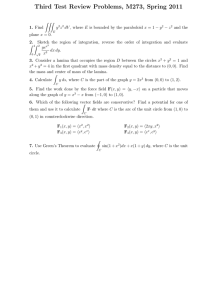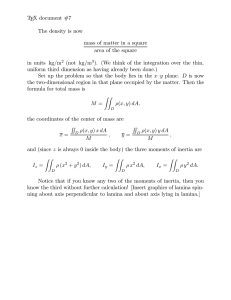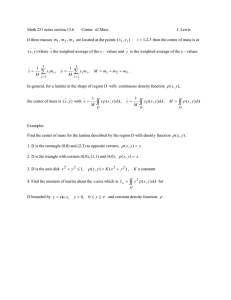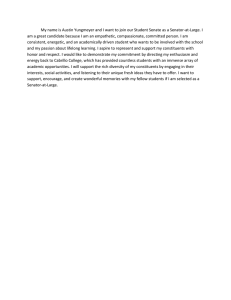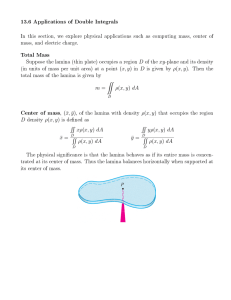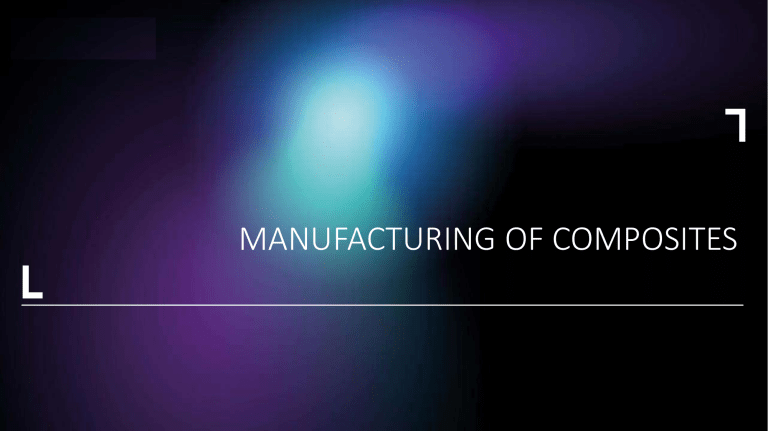
MANUFACTURING OF COMPOSITES ABOUT THIS SESSION • Manufacturing Processes • Pros and Cons • Tooling • Lay ups and curing • Bonding Constituents Lamina Laminates Structure/ Assembly FABRICATION PROCESSES • Prepreg • Filament Winding • Wet Lay-up • Spray-up • Liquid moulding • Compression moulding • Injection moulding • Pultrusion Constituents Lamina Laminates Structure/ Assembly PREPREG • Partly cured composite • Stored in a freezer to prevent further curing and extent shelf life • Lay-up is set on the face of a tool to get the final shape • Tool and part are sealed in a vacuum bag • Oven or autoclave for curing Constituents Lamina Laminates Structure/ Assembly PREPREG Constituents Lamina Laminates Structure/ Assembly PREPREG • Temperature • Pressure • Time • Oven (atmospheric pressure) • Autoclave increased pressure • Compaction • Fibre volume • Void volume • Presses can also be used Constituents Lamina Laminates Structure/ Assembly FILAMENT WINDING Constituents Lamina Laminates Structure/ Assembly • Fibres • Resin bath • Wound around a tool • Requires final part to have a rotational axis • Only specific shapes feasible • Automated process • Lower cost than prepreg • Controllable orientation, fibre volume and orientation Hugo Williams/University of Bristol 2008 WET LAY UP Constituents Lamina Laminates Structure/ Assembly • Similar to prepreg • Not partly cured layers • Placement of dry reinforcement • Impregnate with resin • Build the lay up • Cure (can be done at room temp) Place Dry Ply Impregnate with resin Place next Ply Repeat process until lay up is complete • Using vacuum bag and increased pressure to improve properties. • Can be done with inexpensive tooling (Assuming room temp curing) Hugo Williams/University of Bristol 2008 SPRAY-UP PROCESS Constituents Lamina Laminates Structure/ Assembly • Cost effective • Spray composite on a mould • Does not use Woven or UD plies • Randomly oriented short fibres • Compacted manually with rollers • Lower mechanical properties than others • Not for load-bearing parts Hugo Williams/University of Bristol 2008 MOULDING PROCESSES Constituents Lamina Laminates Structure/ Assembly • Liquid Moulding (Resin Transfer Moulding) • Compression Moulding • Injection Moulding • Preformed Plies • Short Fibre Composites Hugo Williams/University of Bristol 2008 LIQUID MOULDING • Resin Transfer Moulding • Dry preforms placed in a matched metal die • Resin Injected in the mould under pressure • Good dimensional tolerances • Vacuum-assisted RTM (VARTM) Constituents Lamina Laminates Structure/ Assembly COMPRESSION MOULDING • Matched Die Process • Discontinuous, randomly oriented • Moulding Compound (Sheet, bulk) • Compound fills the die and cures in 1-5 min Constituents Lamina Laminates Structure/ Assembly INJECTION MOULDING • Matched Die Process • Discontinuous, randomly oriented • Moulding Compound (Sheet, bulk) • Compound fills the die and cures in 1-5 min • Fast, reliable • Small to medium-sized parts Constituents Lamina Laminates Structure/ Assembly PULTRUSION • Specialized process • Long constant thickness parts • Fibres are drawn through a resin bath • Preformed and passed through a die • Cured in the die • Cut to length Constituents Lamina Laminates Structure/ Assembly 16 TOOLING Constituents • Critical and expensive part of composite manufacturing • Complex and engineering intensive process • Can cause significant problems if done incorrectly • Tool defines the quality of composite • High costs >£500k • Major upfront cost • Saving money on tooling will have serious consequences Lamina Laminates Structure/ Assembly TOOLING • Considerations • • • • • • Wear resistance Uniform heat up Light weight Dimensional stability****** Surface finish** Can withstand loads (700 KPa) Constituents Lamina Laminates Structure/ Assembly TOOLING • Dimensional Stability Constituents Lamina Laminates Structure/ Assembly Temp • Which side is the one to mould? Apply Pressure/Cure Heat up Cool Down Time TOOLING Constituents • Dimensional Stability Lamina Laminates Part Dimension • Which side is the one to mould? 𝑇ℎ𝑒𝑟𝑚𝑎𝑙 𝐶𝑜𝑟𝑟𝑒𝑐𝑡𝑖𝑜𝑛 = 𝑀𝑜𝑢𝑙𝑑 𝐷𝑖𝑚𝑒𝑛𝑠𝑖𝑜𝑛 × (𝐶𝑇𝐸𝑝 − 𝐶𝑇𝐸𝑇 ) × (𝑇𝑔𝑒𝑙 − 𝑇𝑅𝑇 ) Mould Dim * Correction Factor Correction Factor Structure/ Assembly TOOLING • Surface Quality Source: xometry.eu Constituents Lamina Laminates Structure/ Assembly LAY-UP AND CURING Constituents • Automation available for simple parts • Parts that have rotational axis • Manual lay up is the most common way • Low number of parts • Small medium size • Complex parts • Tools exist to assist with the process • Reciprocating or ultrasonic knifes • Laser projection systems to guide the lay up accurately Lamina Laminates Structure/ Assembly LAY-UP AND CURING Constituents Lamina Laminates • Properties of resins • • • • • • Viscosity Void Formation Porosity Dimensional changes Residual stresses Moisture control • Curing requires accurate control of temperature, Pressure, and Time Structure/ Assembly BONDING Constituents • Secondary Bonding • Cocuring • Adhesive bonding is widely used • Depending on the application different ways of curing • Preferred in thin sections • Thick, complex parts are fastened (usually) • Practically if no assembly is required it is better Lamina Laminates Structure/ Assembly BONDING Constituents • Advantages of Adhesive Bonding • • • • Uniform stress distribution Lighter than mechanical fasteners Can work with dissimilar materials Minimum Fatigue crack propagation sensitivity • Disadvantages of Adhesive Bonding • • • • • Permanent joints Requires good surface preparation No reliable non-destructive tests for quality control Adhesives are non recyclable Susceptible to environmental degradation Lamina Laminates Structure/ Assembly BONDING • Destructive testing for the process quality Source: Manufacturing Processes for Advanced Composites Constituents Lamina Laminates Structure/ Assembly SUMMARY This session Next • Manufacturing Processes • Sustainability • Tooling • Case studies • Curing
